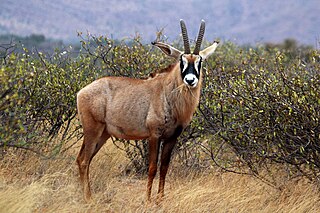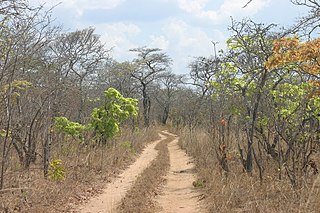
Perissodactyla is an order of ungulates. The order includes about 17 living species divided into three families: Equidae, Rhinocerotidae (rhinoceroses), and Tapiridae (tapirs). They typically have reduced the weight-bearing toes to three or one of the five original toes, though tapirs retain four toes on their front feet. The nonweight-bearing toes are either present, absent, vestigial, or positioned posteriorly. By contrast, artiodactyls bear most of their weight equally on four or two of the five toes: their third and fourth toes. Another difference between the two is that odd-toed ungulates digest plant cellulose in their intestines, rather than in one or more stomach chambers as even-toed ungulates, with the exception of Suina, do.

A rhinoceros, commonly abbreviated to rhino, is a member of any of the five extant species of odd-toed ungulates in the family Rhinocerotidae; it can also refer to a member of any of the extinct species of the superfamily Rhinocerotoidea. Two of the extant species are native to Africa, and three to South and Southeast Asia.

The roan antelope is a large savanna-dwelling antelope found in western, central, and southern Africa. Named for its roan colour, it has lighter underbellies, white eyebrows and cheeks and black faces, lighter in females. It has short, erect manes, very light beards and prominent red nostrils. It is one of the largest antelope, measuring 190–240 cm (75–94 in) from head to the base of the tail, and a 37–48 cm (15–19 in) long tail. Males weigh 242–300 kg (534–661 lb) and females 223–280 kg (492–617 lb). Its shoulder height is around 130–140 cm (51–55 in).

The sable antelope is a large antelope which inhabits wooded savanna in East and Southern Africa, from the south of Kenya to South Africa, with a separated population in Angola.

The white rhinoceros, white rhino or square-lipped rhinoceros is the largest extant species of rhinoceros. It has a wide mouth used for grazing and is the most social of all rhino species. The white rhinoceros consists of two subspecies: the southern white rhinoceros, with an estimated 16,803 wild-living animals, and the much rarer northern white rhinoceros. The northern subspecies has very few remaining individuals, with only two confirmed left in 2018, both in captivity. Sudan, the world's last known male Northern white rhinoceros, died in Kenya on 19 March 2018 at age 45.

Gonarezhou National Park is a national park located in southeastern Zimbabwe. It is situated in a relatively remote corner of Masvingo Province, south of Chimanimani along the Mozambique border. Owing to its vast size, rugged terrain and its location away from main tourist routes, large tracts of Gonarezhou remain pristine wilderness.

The bluebuck or blue antelope is an extinct species of antelope that lived in South Africa until around 1800. It was smaller than the other two species in its genus Hippotragus, the roan antelope and sable antelope. The bluebuck was sometimes considered a subspecies of the roan antelope, but a genetic study has confirmed it as a distinct species.

The Northern Congolian forest–savanna mosaic is a forest and savanna ecoregion of central Africa. It extends east and west across central Africa, covering parts of Cameroon, Central African Republic, Democratic Republic of the Congo, South Sudan, and Uganda. It is part of the belt of transitional forest-savanna mosaic that lie between Africa's moist equatorial Guineo-Congolian forests and the tropical dry forests, savannas, and grasslands to the north and south.

The northern white rhinoceros or northern white rhino is one of two subspecies of the white rhinoceros. This subspecies is a grazer in grasslands and savanna woodlands. Formerly found in several countries in East and Central Africa south of the Sahara, since 19 March 2018, there are only two known rhinos of this subspecies left, named Najin and Fatu, both of which are female; barring the existence of unknown or misclassified male northern white rhinos elsewhere in Africa, this makes the subspecies functionally extinct. The two female rhinos belong to the Dvůr Králové Zoo in the Czech Republic but live in the Ol Pejeta Conservancy in Kenya where they are protected by armed guards.

The Waterberg is a mountainous massif of approximately 654,033 hectare in north Limpopo Province, South Africa. The average height of the mountain range is 600 m with a few peaks rising up to 2,000 m above sea level. Vaalwater town is located just north of the mountain range. The extensive rock formation was shaped by hundreds of millions of years of riverine erosion to yield diverse bluff and butte landform. The ecosystem can be characterised as a dry deciduous forest or Bushveld. Within the Waterberg there are archaeological finds dating to the Stone Age, and nearby are early evolutionary finds related to the origin of humans.

Thuli Parks and Wildlife Land is a protected area in south-western Zimbabwe. It comprises four areas within the Zimbabwe Parks and Wildlife Estate and covers the entire west bank of the Shashe River within the Thuli Circle.
Ceratotherium mauritanicum is a species of fossil African rhinoceros found in the Late Pliocene to early Late Pleistocene of Morocco, Tunisia, and Algeria. It is disputed as to whether remains from the Pliocene of East Africa belong to this species, and if so, whether C. mauritanicum is ancestral to the modern white rhinoceros. During the early Late Pleistocene, sometime between 120-57,000 years ago, it was replaced in North Africa by the modern white rhinoceros.

The southern white rhinoceros or southern white rhino is one of the two subspecies of the white rhinoceros. It is the most common and widespread subspecies of rhinoceros.

The Southern miombo woodlands is a tropical grasslands and woodlands ecoregion extending across portions of Malawi, Mozambique, Zambia, and Zimbabwe.














